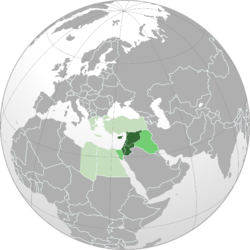Levant
Appearance
| Levant | |
|---|---|
 Kintras o the Levant in the broad, heestoric meanin (equivalent tae the eastren Mediterranean) [1][2][3] Kintras o the Levant in 20t century uisage (equivalent tae Sirie-Palestine) [1]
Kintras an regions sometimes includit in the modren defineetion | |
| Kintras an regions | (Hatay Province) |
| Population | 47,129,325[4] |
| Demonym | Levantine |
| Leids | Levantine Arabic, Ebreu, Aramaic, Armenie, Circassian, Greek, Kurdish, Ladino, Turkis |
| Time Zones | UTC+02:00 (EET) (Turkey an Cyprus) |
The Levant (/ləˈvænt/; Arabic: المشرق /ʔal-maʃriq/[1][5][6][7][8][9][10]) is an approximate heestorical geografical term referrin tae a muckle aurie in the eastren Mediterranean.
References
[eedit | eedit soorce]- ↑ a b c The Oxford Encyclopedia of Ancient Greece and Rome, Volume 1, p247, "Levant"
- ↑ Microsoft Encarta (2009) "Levant"
- ↑ Oxford Dictionaries Online. "Levant." Oxford University Press. Retrieved 4 April 2015.
- ↑ Population foond bi addin aw the kintras' populations (Cyprus, Israel, Jordan, Lebanon, Sirie, Palestine an Hatay Province)
- ↑ Naim, Samia, Dialects of the Levant, in Weninger, Stefan et al. (eds.), The Semitic Languages: An International Handbook, Berlin/Boston: Walter de Gruyter (2011), p. 921
- ↑ Amy Chua (2004), World on Fire: How Exporting Free Market Democracy Breeds Ethnic Hatred and Global Instability p. 212
- ↑ Mandyam Srinivasan, Theodore Stank, Philippe-Pierre Dornier, Kenneth Petersen (2014), Global Supply Chains: Evaluating Regions on an EPIC Framework – Economy, Politics, Infrastructure, and Competence: “EPIC” Structure – Economy, Politics, Infrastructure, and Competence, p. 3
- ↑ Ayubi, Nazih N. (1996), Over-stating the Arab State: Politics and Society in the Middle East p. 108
- ↑ David Thomas, Alexander Mallett (2012), Christian-Muslim Relations. A Bibliographical History. Volume 4 (1200-1350), p. 145
- ↑ Jeff Lesser (1999), Negotiating National Identity: Immigrants, Minorities, and the Struggle for Ethnicity in Brazil p. 45
